Recent updates

Distributed Hierarchical Control for Fast Frequency Restoration in VSG-Controlled Islanded Microgrids
Authors: Kuo Feng, Chunhua Liu Abstract: As microgrids develop rapidly, more inverters are adopted to achieve DC/AC or AC/DC/AC conversion of distributed generators (DGs). Replacing the large rotary generators with inverter-based sources results in a lack of inertia in the grid. The virtual synchronous generator (VSG) control has been proposed to replace the traditional droop control for inverters to provide virtual inertia. In order to restore the frequency to its nominal value, most existing secondary frequency control (SFC) methods are based on frequency measurements. However, while reducing the rate of change of frequency (ROCOF), virtual inertia also slows down the convergence of frequency-based SFC. Therefore, this paper proposes a distributed hierarchical control to generate multi-rate sampling control signals for inverters to achieve stable and fast frequency restoration. The VSG control is adopted to compensate for inertia. Without communication, fast-sampled digital signals control the switch of IGBTs to achieve frequency droop and power sharing. Based on the VSG primary control, a novel distributed event-triggered frequency restoration algorithm is proposed. With highly reduced communication triggers, the power references generated by the proposed control can accelerate the frequency restoration. The low-sampled signal broadcast avoids the influence of frequent and un-convergent control signals. In ...
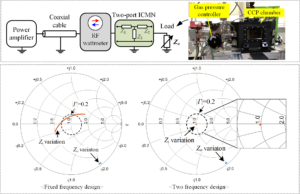
Impedance Compressing Matching Network Based on Two-Port Network Analysis for Wireless Power Transfer System
Authors: Euihoon Chung, Jung-Ik Ha, Anas Al Bastami, David J. Perreault Extended Abstract: This paper proposes a novel design approach for impedance matching networks applicable to diverse industrial fields, including plasma drive systems and wireless power transfer systems. In these industrial applications, the load impedance exhibits a wide range of variation rather than maintaining a fixed value. For instance, in a capacitive-coupled plasma drive system, the load impedance may vary depending on the composition and pressure of the gas. This load impedance variation significantly degrades the output characteristics and efficiency of power amplifiers such as class E or class Φ2. Therefore, to ensure the efficient operation of the power amplifiers, it is essential to have a matching network that compresses load impedance variations. In traditional systems, tunable matching networks have been commonly employed to match the variable load impedance to a fixed input impedance. However, this approach often relies on mechanical devices such as vacuum variable capacitors (VVC), which increase system volume and costs while degrading dynamic performance. To address these issues, a three-port impedance compression network has been proposed that eliminates the need for a mechanical tuning process. However, it still has limitations as it requires implementing two or ...
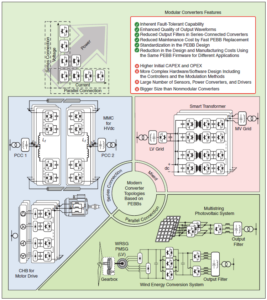
Applications and Modulation Methods for Modular Converters Enabling Unequal Cell Power Sharing
Authors: Vito G. Monopoli, Abraham Marquez, Jose I. Leon, Marco Liserre, Giampaolo Buticchi, Leopoldo G. Franquelo, Sergio Vazquez Extended Abstract: Modular converters based on the connection of multiple power cells have become a competitive solution for many applications, achieving high performance with reduced production and maintenance costs. However, their performance is degraded if the power modules present an unbalanced operation, which is a common case in some applications and/or when they implement active thermal control methods. Variable-angle carrier-based pulsewidth modulation (PWM) strategies face this challenge by minimizing the negative impact of unequal power sharing among the cells. They do this by improving the harmonic quality of the output waveforms, which has a direct impact on the lifetime of the output filters and/or components. 2023 Best paper award for IEEE Industrial Electronics Magazine. Check full paper at: https://ieeexplore.ieee.org/document/9454585 ...
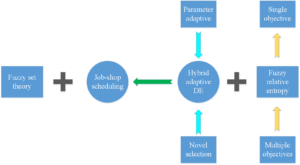
Solving Multi-Objective Fuzzy Job-Shop Scheduling Problem by a Hybrid Adaptive Differential Evolution Algorithm
Authors: Gai-Ge Wang, Da Gao, and Witold Pedrycz Abstract: A common scheduling problem is the job-shop scheduling problem (JSP), where multiple jobs are processed on multiple machines. Each job consists of a series of operations that must be performed in a given order, and each operation must be processed on a specific machine. The key challenge is how to arrange the operations on the machine so that the completion time is the earliest and the energy consumption is the least. The JSP is NP hard, which has very important practical significance. Because of many uncontrollable factors, such as machine delay or human factors, it is difficult to use a single real-number to express the processing and completion time of the jobs. The emergence of fuzzy sets makes the JSP become better aligned with the reality JSP with fuzzy processing time and completion time (FJSP) can model the scheduling more comprehensively, which benefits from the developments of fuzzy sets. Since there are many factors to consider in the production process, such as energy consumption and the completion time, choosing an indicator to evaluate the quality of these factors as a whole is feasible and necessary. Fuzzy relative entropy (FRE) leads to ...
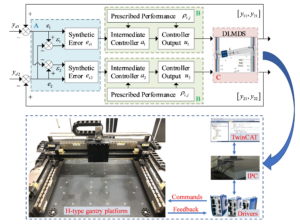
Approximation-Free Robust Synchronization Control for Dual-Linear-Motors-Driven Systems With Uncertainties and Disturbances
Authors: Zhitai Liu, Weiyang Lin, Xinghu Yu, Juan J. Rodríguez-Andina, Huijun Gao Abstract: The dual-linear-motors-driven system (DLMDS) has been increasingly employed in various high-end manufacturing equipment, such as pick-and-place machines, high-end CNC machine tools, and precision instruments, owing to its advantages of high thrust, high precision, and fast response. The complex synchronous structure of the DLMDS increases the difficulty associated with achieving precision control, particularly in terms of synchronization accuracy, thereby imposing stringent demands on control algorithms. This paper presents an approximation-free robust synchronization control scheme that incorporates prescribed performance constraints to attain precise control. Initially, a synthetic error that can simultaneously describe tracking accuracy and synchronization accuracy is formulated to facilitate controller design by using cross-coupling control. Subsequently, a robust controller is devised, featuring prescribed transient and steady-state performance, amalgamating the advantages of prescribed performance control and back-stepping control. Importantly, the proposed scheme obviates the need for explicit model information or any approximation techniques to handle system uncertainties, such as identification, observers, and intelligent learning, thereby significantly reducing the complexity of the controller. By appropriately selecting performance functions, the transient and steady-state responses of the synthetic error can be constrained, thereby achieving the desired control performance. Notably, the prescribed performance ...
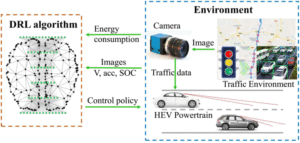
Hybrid Electric Vehicle Energy Management with Computer Vision and Deep Reinforcement Learning
Authors: Yong Wang, Huachun Tan, Yuankai Wu, Jiankun Peng Abstract: Modern automotive systems have been equipped with a highly increasing number of onboard computer vision hardware and software, which are considered to be beneficial for achieving eco-driving. This article combines computer vision and deep reinforcement learning (DRL) to improve the fuel economy of hybrid electric vehicles. The proposed method is capable of autonomously learning the optimal control policy from visual inputs. The state-of-the-art convolutional neural networks-based object detection method is utilized to extract available visual information from onboard cameras. The detected visual information is used as a state input for a continuous DRL model to output energy management strategies. To evaluate the proposed method, we construct 100 km real city and highway driving cycles, in which visual information is incorporated. The results show that the DRL-based system with visual information consumes 4.3-8.8% less fuel compared with the one without visual information, and the proposed method achieves 96.5% fuel economy of the global optimum-dynamic programming. 2022 Outstanding Paper Award for the IEEE Transactions on Industrial Informatics Check full paper at: https://ieeexplore.ieee.org/document/9165215 ...

An Improved Open-Phase Fault-Tolerant DTC Technique for Five-Phase Induction Motor Drive Based on Virtual Vectors Assessment
Authors: Bheemaiah Chikondra, Utkal Ranjan Muduli and Ranjan Kumar Behera Abstract: The multi-phase machine (MM) drives are best suitable for safety-critical applications due to its inherent fault-tolerant capability. The fault-tolerant operation of MM drives is challenging and necessary for applications such as off-shore ship propulsion, high-way electric vehicles, and more electric aircraft. A two-level voltage source inverter (VSI) fed five-phase induction motor (FPIM) drive has been considered for the post-fault performance assessment. In this paper, an improved fault-tolerant direct torque control (DTC) technique is proposed for the FPIM drive based on virtual vector (VV)s assessment under the open-phase fault condition. The theoretical analysis is carried out to investigate the impact of VVs on the change in torque as well as flux response at different speeds and loading conditions. Based on this analysis, a modified lookup table, flux, and torque hysteresis bands are designed to improve the functioning of the fault-tolerant DTC of FPIM drive. The FPIM drive performance is analyzed and tested experimentally with an open-phase fault. Studies have confirmed the reliability and superiority of the proposed DTC controller over existing post-fault solutions. In addition, the robustness of the FPIM drive at steady-state and dynamic operating conditions is evaluated from ...
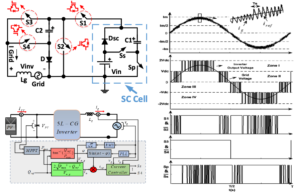
Six-Switch Step-Up Common-Grounded Five-Level Inverter With Switched-Capacitor Cell for Transformerless Grid-Tied PV Applications
Authors: Reza Barzegarkhoo, Yam. P. Siwakoti, Naser Vosoughi, and Frede Blaabjerg Abstract: Photovoltaic (PV) string inverters with transformerless grid-connected architecture are the most commonly used solar converters owing to their appliance-friendly and cost-effective benefits. A novel circuit configuration for these converters is presented in this study, which seeks to address the shortcomings of most of the conventional topologies such as the problem of leakage current, voltage ratio transformations, and power quality. The proposed structure is based on the series-parallel switching conversion of the switched-capacitor (SC) cell and is comprised of only six unidirectional power switches with a common-grounded (CG) feature. Through the use of the SC cell and the CG connection of active and passive used elements, not only is the number of output voltage level enhanced by up to five but also a two times voltage boosting feature with a single stage operation as well as elimination of the leakage current is acquired. Herein, to inject a tightly controlled current into the grid, a peak current controller approach has been used which can handle both the active and reactive power supports modes. Details of the proposed CGSC-based 5L inverter and its closed-loop control diagram with the typical waveforms of ...
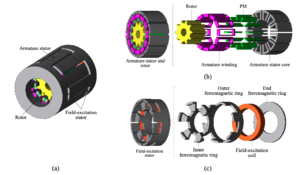
Flux-Regulation Principle and Performance Analysis of a Novel Axial Partitioned Stator Hybrid-Excitation Flux-Switching Machine Using Parallel Magnetic Circuit
Authors: Xianglin Li, Fawen Shen, Shiyang Yu and Zhiwei Xue Abstract: This paper presents a novel hybrid-excitation flux-switching (HEFS) machine with axial partitioned stator (APS) arrangement, which can achieve the independent accommodation of armature winding and field-excitation winding, thus enhancing the field-excitation capability and improving the winding heat dissipation. More importantly, a particular parallel-magnetic-circuit (PMC) hybrid-excitation pattern consisting of the axial and radial magnetic paths is innovatively developed in the HEFS machine, which is an effective solution for improving the flux-regulation ability. Consequently, the PMC-based flux-regulation principle is comprehensively illustrated. Moreover, by investigating the flux-regulation characteristics of three structural feasible APS-HEFS topologies, the bilateral complementary structure is finally determined as the preferred option. By using the multi-objective optimization method and the three-dimensional finite-element analysis (FEA), the dimensional parameter optimization design of the proposed machine is conducted, and the performance comparison with conventional HEFS counterparts is also carried out to prove the flux-regulation superiority of the proposed design. Finally, a prototype is fabricated for experimental testing, and the measured results are in good agreement with the FEA, which verifies the validity of the proposed APS-HEFS topology and its theoretical flux-regulation principle analysis. 2022 Outstanding Paper Award for the IEEE Transactions on Industrial ...
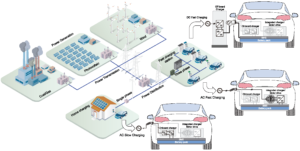
Electric Vehicle Charging Infrastructure: From Grid to Battery
Authors: Sebastian Rivera, Samir Kouro, Sergio Vazquez, Stefan M. Goetz, Ricardo Lizana, Enrique Romero-Cadaval Extended Abstract: This article provides an in-depth perspective on the efforts being made to achieve zero-emission transportation, focusing particularly on the developments of electric vehicle (EV) charging infrastructure and charging standards during the last decade. This paper overviews how power electronics configurations enable different aspects of battery charging, exploring the different charging mechanisms and levels, providing a detailed industrial survey of mainstream solutions and the different options enabling the energy transfer from the grid to the battery. In addition, the paper discusses how these solutions align with the existing charging standards and their recent updates, covering the challenges and opportunities this developing industry faces. Finally, the article highlights the benefits of having a versatile and vast public charging infrastructure, capable of promoting future-proof solutions, deploying charging rates and capabilities that are not available yet in commercialized vehicles, and more importantly how this is essential to gain consumer trust and accelerate EV adoption. 2022 Best paper award for IEEE Industrial Electronics Magazine. Check full paper at: https://ieeexplore.ieee.org/document/9343759 ...
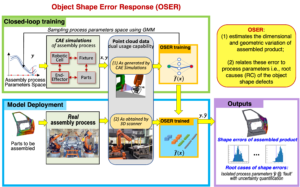
Object Shape Error Response using Bayesian 3D Convolutional Neural Networks for Assembly Systems with Compliant Parts
Authors: Sumit Sinha, Pasquale Franciosa and Dariusz Ceglarek from University of Warwick, U.K. Abstract: The article contributes to the overall initiative driving zero-defect manufacturing strategy by accelerating the development of in-process quality improvement capabilities, specifically Root Cause Analysis (RCA) of quality (6-sigma) defects in multi-station assembly systems. In recent years, deep learning architectures have matured significantly to provide unprecedented capabilities for RCA of quality defects in complex manufacturing systems which was otherwise infeasible using previous statistical approaches. This article proposes a novel object shape error response (OSER) to estimate the dimensional and geometric variations of assembled products and then, relates these to process parameters, which can be interpreted as root causes (RC) of the object shape defects. The presented OSER deep learning architecture is underpinned by integrating (i) Bayesian deep learning with (ii) 3D Convolutional Neural Networks (CNN); and, (iii) Computer-Aided Engineering (CAE) simulations of assembly systems. Compared with existing methods, the OSER: (1) addresses a novel problem of applying deep learning for object shape error identification instead of object detection; (2) overcomes fundamental performance limitations of current linear approaches for RC analysis (RCA) of assembly systems that cannot be used on point cloud data; and, (3) provides capabilities for ...
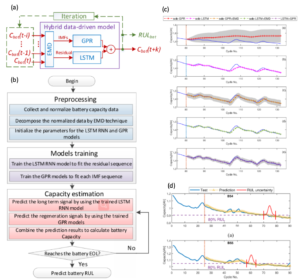
A Data-Driven Approach With Uncertainty Quantification for Predicting Future Capacities and Remaining Useful Life of Lithium-ion Battery
Authors: Kailong Liu; Yunlong Shang; Quan Ouyang; Widanalage Dhammika Widanage Abstract: As a key technology to effectively bypass fossil fuels and promote net-zero target around the world, batteries inevitably age with time, losing the capacity to store charge and deliver it efficiently. This directly affects energy system safety and efficiency, making related battery health management (BHM) necessary. Predicting future capacities and remaining useful life (RUL) with uncertainty quantification is a key but challenging issue in the applications of BHM. This article applies advanced machine-learning techniques to achieve effective future capacities and RUL prediction for lithium-ion (Li-ion) batteries with reliable uncertainty management. To be specific, after using the empirical mode decomposition (EMD) method, the original battery capacity data is decomposed into some intrinsic mode functions (IMFs) and a residual. Then, the long short-term memory (LSTM) submodel is applied to estimate the residual while the Gaussian process regression (GPR) submodel is utilized to fit the IMFs with the uncertainty level. Consequently, both the long-term dependence of capacity and uncertainty quantification caused by the capacity regenerations can be captured directly and simultaneously. Experimental aging data from different batteries are deployed to evaluate the performance of proposed LSTM+GPR model in comparison with the solo GPR, ...
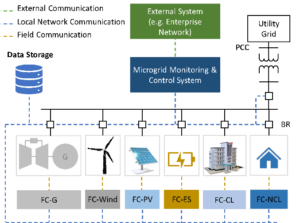
Cyber-Physical Microgrids: Toward Future Resilient Communities
Authors: Tuyen V. Vu, Bang L.H. Nguyen, Zheyuan Cheng, Mo-Yuen Chow and Bin Zhang Extended Abstract: Microgrids are the most promising component of the power system capable of ensuring resilient energy services for critical infrastructure that is impacted by either natural disasters or man-made incidents. Microgrids can be isolated from large-scale power transmission/distribution systems (macrogrids) to deliver energy to their local communities using local energy resources and distribution systems when power outages occur in the macrogrids. In such situations, microgrids could be considered as the last available resource to provide energy to critical infrastructure. Research in monitoring and control of microgrids has been ongoing for the last two decades to protect and enhance communities’ socio-economic performance. However, of increasing concern are the possible cyber-physical threats that could disrupt the provision of macrogrids’ energy services to critical infrastructure and consequently impact the resilience and sustainability of communities. As cyber-physical systems, microgrids are not immune to these threats. Advanced monitoring and control are critical for real-time operations of microgrids and, therefore, directly influence communities’ resilience. Research trends in monitoring have recently shifted from normal situational awareness in forecasting, state estimation, and prediction to anomalies’ analysis and cyber-physical attacks’ detection to support resilient ...

A Constant Switching Frequency Multiple-Vector-Based Model Predictive Current Control of Five-Phase PMSM With Nonsinusoidal Back EMF
Authors: Cong Xiong, Haiping Xu, Tao Guan, Peng Zhou Extended Abstract: Multi-phase motors are becoming popular in high-power propulsion scene, and different control strategies have been adopted to and optimized for them to achieve higher drive performance. Among these the model predictive current control (MPCC) method stands out for its accuracy and quicker dynamic response. But it still has some shortages that limit its application. Most of the existing finite-control-set model predictive current control (FCS-MPCC) schemes for multi-phase motor suffer from heavy computational burden, inevitable low-order harmonic currents, and variable switching frequencies. Some virtual voltage vector (V3)-based FCS-MPCC schemes can effectively suppress harmonic current by zeroing the harmonic subspace voltage on average during one sampling period. However, they fail when the motor has a nonsinusoidal back electromotive force. In order to solve the aforementioned issues, this paper proposes a constant switching frequency multiple-vector-based FCS-MPCC scheme. Unlike the traditional FCS-MPCC schemes, the proposed scheme selects optimal V3s and their duty ratios in two orthogonal subspaces. Thus, it can simultaneously track the references in both orthogonal subspaces. In this approach, the optimal V3s and their duty ratios are directly obtained from the principle of deadbeat current control without time-consuming enumeration-based state predictions and ...

Dynamical Resource Allocation in Edge for Trustable Internet-of-Things Systems: A Reinforcement Learning Method
Authors: Shuiguang Deng, Zhengzhe Xiang, Peng Zhao, Javid Taheri, Honghao Gao, Jianwei Yin, Albert Y. Zomaya Abstract: Edge computing (EC) is now emerging as a key paradigm to handle the increasing Internet-of-Things (IoT) devices connected to the edge of the network. By using the services deployed on the service provisioning system which is made up of edge servers nearby, these IoT devices are enabled to fulfill complex tasks effectively. Nevertheless, it also brings challenges in trustworthiness management. The volatile environment will make it difficult to comply with the service-level agreement (SLA), which is an important index of trustworthiness declared by these IoT services. In this paper, by denoting the trustworthiness gain with how well the SLA can comply, we attempt to encode the state of the edge-computing based service provisioning system and the resource allocation scheme, and then we model the resource adjustment for services as a Markov Decision Process (MDP) so that the newly used resource allocation scheme after adjustment can be evaluated by the trustworthiness gain of the next time period. Based on these, we develop a simple but effective simulator as the training environment of the edge computing based service provisioning system and then get a trained ...
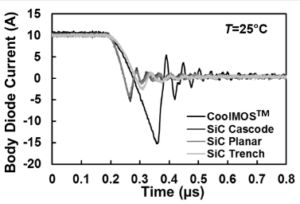
Performance and Reliability Review of 650 V and 900 V Silicon and SiC Devices: MOSFETs, Cascode JFETs and IGBTs
Authors: Jose Ortiz Gonzalez, Ruizhu Wu, Saeed Jahdi, Olayiwola Alatise Extended Abstract: The future of power conversion at low-to-medium voltages (around 650 V) poses a very interesting debate. At low voltages (below 100 V), the silicon (Si) MOSFET reigns supreme and at the higher end of the automotive medium-voltage application spectrum (approximately 1 kV and above) the SiC power MOSFET looks set to topple the dominance of the Si insulated-gate bipolar transistor (IGBT). At very high voltages (4.5 kV, 6.5 kV and above) used for grid applications, the press-pack thyristor remains undisputed for current source converters and the press-pack IGBTs for voltage source converters. However, around 650 V, there does not seem to be a clear choice with all the major device manufacturers releasing different technology variants ranging from SiC Trench MOSFETs, SiC Planar MOSFETs, Cascode-driven WBG FETs, silicon NPT and Field-stop IGBTs, silicon super-junction MOSFETs, standard silicon MOSFETs, and enhancement mode GaN high electron mobility transistors (HEMTs). Each technology comes with its unique selling point with gallium nitride (GaN) being well known for ultrahigh speed and compact integration, SiC is well known for high temperature, electro-thermal ruggedness, and fast switching while silicon remains clearly dominant in cost and proven ...
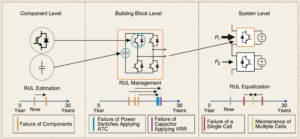
Power Routing – A New Paradigm for Maintenance Scheduling
Authors: Marco Liserre, Giampaolo Buticchi, Jose Ignacio Leon, Abraham M. Alcaide, Vivek Raveendran, Youngjong Ko, Markus Andresen, Vito G. Monopoli, Leopoldo Franquelo Extended Abstract: Currently, the necessity of efficient and reliable power systems is increasing because of the strict requirements that standards and regulations impose, but still costs have to remain low. The monitoring and control of the components lifetime can lead to reduce the maintenance costs. However, overcoming the related challenges is not a straightforward task, as it involves knowledge of power device physics, smart management of electrical quantities, and optimal maintenance planning and scheduling. It represents a multidisciplinary issue being faced in the last decade. In this work, a new paradigm is proposed: the power routing for the maintenance scheduling. Power routing is the control technique for which each module building up a modular power converter processes a different amount of power or faces a different voltage/current stress combination. In this way, it is possible to relieve the stress from some parts of the power converter and shift it to other parts. Coupled with state-of-health detection algorithms for the power modules and the capacitor, the power routing is the tool that allows having the time of failure as ...
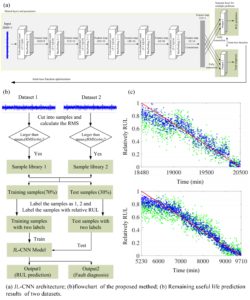
Simultaneous Bearing Fault Recognition and Remaining Useful Life Prediction Using Joint-Loss Convolutional Neural Network
Authors: Ruonan Liu; Boyuan Yang; Alexander G. Hauptmann Abstract: Fault diagnosis and remaining useful life (RUL) prediction are always two major issues in modern industrial systems, which are usually regarded as two separated tasks to make the problem easier but ignore the fact that there are certain information of these two tasks that can be shared to improve the performance. Therefore, to capture common features between different relative problems, a joint-loss convolutional neural network (JL-CNN) architecture is proposed in this paper, which can implement bearing fault recognition and RUL prediction in parallel by sharing the parameters and partial networks, meanwhile keeping the output layers of different tasks. The JL-CNN is constructed based on a CNN, which is a widely used deep learning method because of its powerful feature extraction ability. During optimization phase, a JL function is designed to enable the proposed approach to learn the diagnosis-prognosis features and improve generalization while reducing the overfitting risk and computation cost. Moreover, because the information behind the signals of different problems has been shared and exploited deeper, the generalization and the accuracy of results can also be improved. Finally, the effectiveness of the JL-CNN method is validated by run-to-failure dataset. Compared with ...

Nonlinear Control of Underactuated Systems Subject to Both Actuated and Unactuated State Constraints With Experimental Verification
Authors: He Chen; Ning Sun Extended Abstract: Currently, underactuated systems are widely utilized in our daily life, which have the property that there are fewer control inputs than the to-be-controlled degrees of freedom (DOFs). Compared with fully-actuated systems, since fewer actuators are needed, underactuated systems have many advantages. However, because fewer control inputs are used to dominate more DOFs, the control issues of underactuated systems are usually much more challenging than those of fully-actuated systems. In practice, due to limited workspace or safety concerns, the state variables of underactuated systems should be constrained within allowable ranges. For instance, when a crane system transports liquid cargoes, swing angle amplitudes should never exceed a certain safety limit. If these state constraints are roughly neglected, the correspondingly designed control methods may be invalid in some situations. In this paper, we propose a new control strategy for a class of underactuated systems, which can treat various constraints, including actuated and unactuated state constraints and the constraints on some specific composite variables. Specifically, we elaborately design some new auxiliary terms that are composed of constrained variable signals and actuated velocity signals. These terms can enhance the couplings between unactuated and actuated state variables, which are ...
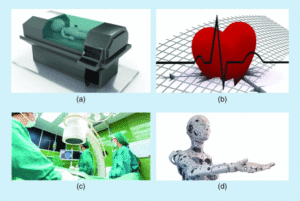
Industrial Electronics for Biomedicine: A New Cancer Treatment Using Electroporation
Authors: Oscar Lucia; Hector Sarnago; Tomas Garcia-Sanchez; Lluis M. Mir; Jose M. Burdio Abstract: This article reviewed the application of IEs to biomedicine, with an emphasis on the practice's potential benefits and necessary collaboration between specialist engineers and medical practitioners. The design of high-voltage generators for electroporation is a challenging task due to the stiff requirements for the voltage amplitude, controllability, isolation, and output impedance. electroporation has been acknowledged as a key tool for cancer treatment that has a growing importance despite the significant challenges that must still be faced, The future of this technology will require the development of versatile generators that overcome all of the current limitations and provide useful tools for research and clinical treatments. To achieve the goal, several IE technologies will play a fundamental role. Research on advanced topologies will be essential, as will be the use of faster and higher-voltage devices, such as those based on silicon carbide and gallium nitride. Advanced control architectures and will be required to accurately control the generator, monitor and optimize the treatment, and guarantee the safety of patients and medical teams. There is a brilliant future for the IEs that are applied to ER. Outstanding paper award ...
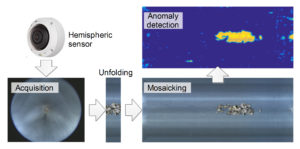
A Vision-Based System for Internal Pipeline Inspection
Claudio Piciarelli, Danilo Avola, Daniele Pannone, Gian Luca Foresti Extended abstract: The regular internal inspection of waterworks or sewer pipelines is a fundamental maintenance task to guarantee the correct functionality of the infrastructure and to prevent incidents. Even if the pipeline is designed to last for a long period of time, it can be affected by a wide range of problems, such as cracks, collapses, defective junctions, obstructions, etc. Ignoring such defects could lead to system inefficiency, economic losses, environmental issues, or even potential dangers for human beings. Visual inspection of the internal surface of pipelines is usually done by means of robotic rovers or floating platforms, mounting proper camera sensors and lights. The inspection can be done either on-line or off-line. In the first case, a human operator can see the acquired video as the inspection is being executed, and he can monitor the internal surface by means of a motorized camera head, which can be manually oriented. The advantage of on-line approaches is that defects can be detected in real-time, however it is often unpractical in long pipelines because of the lack of a reliable communication between the sensor and the display base. In the off-line approaches, a ...
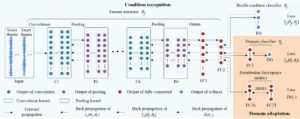
Deep Convolutional Transfer Learning Network: A New Method for Intelligent Fault Diagnosis of Machines with Unlabeled Data
Liang Guo, Yaguo Lei, Saibo Xing, Tao Yan, and Naipeng Li Extended abstract: Intelligent fault diagnosis is able to handle massive monitoring data and distinguish health conditions of machines, which has attracted much attention from both researchers and engineers recently. Generally, the success of intelligent fault diagnosis relies on two conditions: 1) Labeled data are available to provide fault information. 2) The training and testing data are subject to the same probability distribution. However, for some machines, it is difficult to satisfy the above two conditions due to the following aspects. 1) Labeled fault data are difficult to obtain from some machines. 2) An intelligent fault diagnosis method trained with labeled data acquired from one machine possibly fails in classifying unlabeled data acquired from other machines. The above two aspects limit the applications of intelligent methods in diagnosing mechanical faults. As a potential tool to solve the above problem, transfer learning is equipped with the ability to reduce the distribution discrepancy between a source domain and the target domain. This paper proposes a new intelligent method named deep convolutional transfer learning network (DCTLN) to diagnose mechanical faults without labeled data available. DCTLN consists of two modules: condition recognition and domain ...
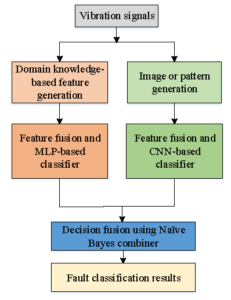
Multiple Classifiers and Data Fusion for Robust Diagnosis of Gearbox Mixed Faults
Authors: Jagath Sri Lal Senanayaka; Huynh Van Khang; Kjell G. Robbersmyr Extended Abstract: Detection and isolation of single and mixed faults in a gearbox are essential to enhance the system reliability, lifetime, and service availability. This paper proposes a hybrid learning scheme for gearbox mixed fault diagnosis applications, consisting of multilayer perceptron (MLP)- and convolutional neural network (CNN)-based classifiers, and data fusion for enhancing the robustness. The MLP classifier uses domain knowledge features generated by measuring energies from several frequency bands in the vibration spectrum. The CNN algorithm is trained to identify patterns in the spectrograms of vibration signals via continuous Wavelet transform. A data fusion framework is introduced to improve the robustness and accuracy of the learning algorithms so that the proposed diagnosis scheme can work effectively regardless of noises in the measured data. Within the framework, data fusion is used at feature and decision levels. A Naïve Bayes combiner is selected to fuse results of the individual classifiers at the decision level to enhance the reliability of the fault classification. The robustness of the proposed scheme is tested using two types of noises, namely white Gaussian noise, representing sensor noise and mixing the original vibration signal with another ...
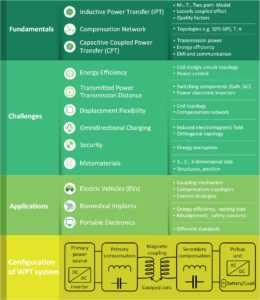
Wireless Power Transfer – An Overview
Authors: Zhen Zhang; Hongliang Pang; Apostolos Georgiadis; Carlo Cecati Extended Abstract: Due to their simple use, battery-powered devices are becoming widely required in many fields. Moreover, electric vehicles, and autonomous mobile platforms, are expected to be very popular but their use is severely affected by the high cost, heavy weight, encumbrance and low energy density of the batteries. As a novel pattern of energization, the wireless power transfer (WPT) offers a band new way to the energy acquisition for electric-driven devices, thus alleviating the over-dependence on the battery. The paper entitled: Wireless Power Transfer – An Overview, has overviewed the WPT techniques, with emphasis on fundamentals, technical challenges, metamaterials, and typical applications. The manuscript firstly introduced the working mechanism of inductive power transfer (IPT) systems, then, it compared four typical capacitive compensation networks, and elaborated the magnetic resonant coupling effect as well as the capacitive coupled power transfer (CCPT) mechanism. Then, it has given the answers to two technical questions, namely
- why the 2-coils IPT system is commonly used for short-range (shorter than the coil diameter) transmission?
- and why the 4-coils IPT system can extend the transmission distance to the mid-range applications?
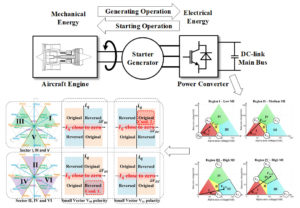
A Modified Neutral Point Balancing Space Vector Modulation for Three-Level Neutral Point Clamped Converters in High-Speed Drives
Authors: Chen Li; Tao Yang; Ponggorn Kulsangcharoen; Giovanni Lo Calzo; Serhiy Bozhko; Christopher Gerada; Patrick Wheeler Extended Abstract: Since the beginning of the More Electric Aircraft (MEA) concept an increasing number of hydraulic, pneumatic and mechanical aircraft functional systems have been considered for replacement by electrical systems to improve fuel efficiency and to reduce emissions. One of the key technologies for the MEA is the aircraft electrical starter generator (ESG) system which enables starting aircraft engine electrically and using the engine to run a generator when the engine reaches a self-sustained speed. Earlier studies presented a novel 270Vdc, 45kVA, 32krpm integrated aircraft starter/generator system. This system consists of a high speed surface-mount permanent magnet synchronous machine and a three-level neutral-point-clamped (NPC) converter. During the engine start-up process, the ESG accelerates the engine shaft up to the ignition speed. In generation mode, the ESG extracts power from the engine shaft and supplies various onboard electrical loads through the three-level converter. This paper describes a high performance neutral-point voltage balancing space vector modulation technique for the three-level NPC converter within the proposed ESG system. Conventional three-level converter space vector modulation schemes do not function well under low power factor, low sample-time-ratio and ...
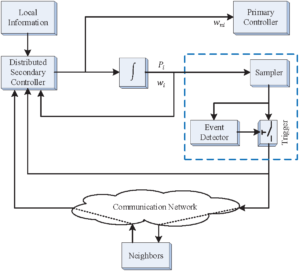
Distributed Secondary Control for Active Power Sharing and Frequency Regulation in Islanded Microgrids Using an Event-triggered Communication Mechanism
Authors: Lei Ding; Qing-Long Han; Xian-Ming Zhang Extended Abstract: As a promising paradigm of power grids, a microgrid has been gaining popularity due to its strong ability of integration of renewable energy sources such as wind turbines, photovoltaic arrays and fuel cells. The large-scale penetration of such distributed energy sources makes it costly and sometimes impractical to carry out a centralized control scheme for microgrids. As a result, it is more desirable for microgrids to adopt a distributed control scheme which requires support from communication networks. While the distributed control scheme can improve the reliability, efficiency and scalability of microgrids of microgrids, it always suffers from the limitation of communication resources, probably resulting in detrimental consequences, such as degradation or even damage of control performance. Therefore, it is essential and critical to develop a new and efficient distributed control for microgrids subject to limited communication resources. This article is concern with active power sharing and frequency regulation in an islanded microgrid under event-triggered communication. A distributed secondary control scheme with a sampled-data-based event-triggered communication mechanism is proposed to achieve active power sharing and frequency regulation in a unified framework, where neighbourhood sampled-data exchange occurs only when the predefined triggering condition ...
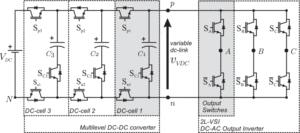
Reduced Multilevel Converter: A Novel Multilevel Converter with a Reduced Number of Active Switches
Authors: Margarita Norambuena ; Samir Kouro ; Sibylle Dieckerhoff ; Jose Rodriguez Extended Abstract: Multilevel converters have made a strong entrance in the low voltage market (typically below 690V), particularly for wind and photovoltaic energy conversion systems, UPS, and EV fast-charging stations. Since the device blocking voltage is not an issue in this voltage range, the main driver behind this trend is the more demanding grid codes, the filter size reduction, and the increased efficiency, which are directly or indirectly achieved by the more sinusoidal multilevel voltage waveforms. However since these applications are reaching quite high power levels (e.g. several wind turbines above 5MW, central PV inverters above 2MW), they require several converters operating in parallel, multichannel or interleaved mode. In fact, some PV inverters have up to 12 converters (four per phase) to reach 2MW. In these cases, a reduction in the number of active devices and capacitors for each individual converter could translate in cost reduction, higher power density and less failure probability (less gate drives and capacitors). This paper proposes a new multilevel converter topology which reduces the number of power switches and capacitors to generate the same or more number of output voltage levels as traditional ...
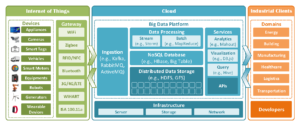
Industrial Cyberphysical Systems: Realizing Cloud-Based Big Data Infrastructures
Authors: Bo Cheng ; Jingyi Zhang ; Gerhard P. Hancke ; Stamatis Karnouskos ; Armando Walter Colombo Extended Abstract: Internet of Things (IoT) technology provides new opportunities to build powerful industrial systems by connecting a large number of smart networked embedded devices. Devices within these industrial IoT (IIoT) or industrial cyber physical systems (ICPSs) can sense and control physical processes, make autonomous decisions, and communicate and cooperate, thereby collectively generating a massive amount of system data. By capturing, processing, and analyzing significant amounts of data from these devices effectively, industrial companies and organizations can manage their enterprise resources, optimize technical processes, understand the market demand, and develop business intelligence and analytics (BI&A). Due to poor scalability and low performance, many traditional computing technologies are inadequate for handling big data, which are characterized by the volume, velocity, variety, and veracity of the data (each of these characteristics applies to ICPS data). The volume of data will grow with the adoption of IIoT technology. The velocity, i.e., the rate at which data are generated, ingested, and processed, is crucial for decisions that feed back into the system to control real-time industrial processes. Since the ICPS consists of heterogeneous systems of systems, the ...
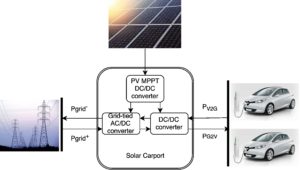
Energy Management System With PV Power Forecast to Optimally Charge EVs at the Workplace
Authors: Dennis van der Meer ; Gautham Ram Chandra Mouli ; Germán Morales-España Mouli ; Laura Ramirez Elizondo ; Pavol Bauer Extended Abstract: The number of battery electric vehicles (BEVs) increases rapidly. Some countries, such as Norway and Denmark, are considering banning internal combustion vehicles in the coming decade and the BEV is typically seen as their replacement. However, uncontrolled charging of BEVs poses challenges to the operational performance of the electricity grid while the improvement in greenhouse gas emissions that BEVs offer could be nullified when these are charged with electricity generated from coal or gas fired power plants. To that end, we present an energy management system (EMS) capable of forecasting photovoltaic (PV) power production of a solar carport and optimizing power flows between the solar carport, grid, and BEVs at the workplace. The aim is to minimize the charging cost while reducing the energy demand from the grid by increasing PV self-consumption and consequently increasing sustainability of the BEV fleet. The developed EMS consists of two components: An autoregressive integrated moving average model to predict PV power production and a mixed-integer linear programming framework that optimally allocates power to minimize charging cost. The results show that the ...
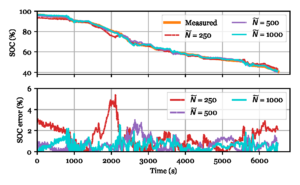
Long Short-Term Memory Networks for Accurate State-of-Charge Estimation of Li-ion Batteries
Authors: Ephrem Chemali ; Phillip J. Kollmeyer ; Matthias Preindl ; Ryan Ahmed ; Ali Emadi Extended Abstract: About half of the total health-related economic cost due to outdoor air pollution can be attributed to the road transport sector. As a result, some countries, like Norway, are considering plans to ban petrol and diesel powered vehicles by 2025. State of charge (SOC) estimation is critical to the safe and reliable operation of Li-ion battery packs, which nowadays are becoming increasingly used in electric vehicles (EVs), Hybrid EVs, unmanned aerial vehicles, and smart grid systems. We introduce a new method to perform accurate SOC estimation for Li-ion batteries using a recurrent neural network (RNN) with long short-term memory (LSTM). The time series-nature of battery data is a great fit for a LSTM-RNN which is widely recognized for its strong performance when encoding dynamics in time. We showcase the LSTM-RNN’s ability to encode dependencies in time and accurately estimate SOC. The LSTM-RNN can map battery measurement signals like voltage, current, and temperature directly to the battery SOC, avoiding computationally intensive filters and inference algorithms like Kalman filters used in traditional SOC estimators. In addition, this machine-learning technique, like all others, is capable ...

Intelligent Buildings of the Future: Cyberaware, Deep Learning Powered, and Human Interacting
Authors: Milos Manic ; Kasun Amarasinghe ; Juan J. Rodriguez-Andina ; Craig Rieger Abstract: Intelligent buildings are quickly becoming cohesive and integral inhabitants of cyberphysical ecosystems. Modern buildings adapt to internal and external elements and thrive on ever-increasing data sources, such as ubiquitous smart devices and sensors, while mimicking various approaches previously known in software, hardware, and bioinspired systems. This article provides an overview of intelligent buildings of the future from a range of perspectives. It discusses everything from the prospects of U.S. and world energy consumption to insights into the future of intelligent buildings based on the latest technological advancements in U.S. industry and government. 2017 Best paper award for IEEE Industrial Electronics Magazine Check full paper at: https://ieeexplore.ieee.org/document/7792825 ...
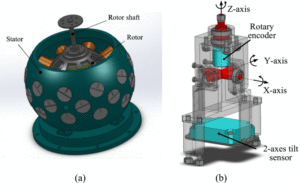
A Robust Adaptive Iterative Learning Control for Trajectory Tracking of Permanent-Magnet Spherical Actuator
Authors: Liang Zhang ; Weihai Chen ; Jingmeng Liu ; Changyun Wen Abstract: This paper presents a robust adaptive iterative learning control (ILC) algorithm for 3-DOF permanent magnet (PM) spherical actuators to improve their trajectory tracking performance. The dynamic model of a PM spherical actuator is a multivariable nonlinear system with interaxis coupling terms. Uncertainties such as modeling errors, loads, and external disturbances exist in the model unavoidably, which will affect the performance, including the precision of the control system. Hence, to compensate for these uncertainties, a new hybrid control scheme that consists of a proportional–derivative (PD) feedback control with varying gains, a PD-type ILC with adjustable gains, and a robust term is developed. The new control law combines the advantages of simplicity and easy design of the PD control, the effectiveness of the ILC to handle model uncertainties and repetitive disturbances, and the robustness of the robust term to random disturbances. In addition, to expedite the convergence rate, the gains in the PD feedback control and the PD-type ILC are adaptively adjusted according to the iteration times. It is shown that the system tracking error approaches zero as the number of iterations increases ...
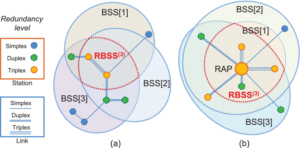
Seamless Link-Level Redundancy to Improve Reliability of Industrial Wi-Fi Networks
Authors: Gianluca Cena ; Stefano Scanzio ; Adriano Valenzano Abstract: The adoption of wireless communications and, in particular, Wi-Fi, at the lowest level of the factory automation hierarchy has not increased as fast as expected so far, mainly because of serious issues concerning determinism. Actually, besides the random access scheme, disturbance and interference prevent reliable communication over the air and, as a matter of fact, make wireless networks unable to support distributed real-time control applications properly. Several papers recently appearing in literature suggest that diversity could be leveraged to overcome this limitation effectively. In this paper, a reference architecture is introduced, which describes how seamless link-level redundancy can be applied to Wi-Fi. The framework is general enough to serve as a basis for future protocol enhancements, and also includes two optimizations aimed at improving the quality of wireless communication by avoiding unnecessary replicated transmissions. Some relevant solutions have been analyzed by means of a thorough simulation campaign, in order to highlight their benefits when compared with conventional Wi-Fi. Results show that both packet losses and network latencies improve noticeably. 2017 Best paper award for IEEE Transactions on Industrial Informatics Check full paper at: https://ieeexplore.ieee.org/document/7393813 ...

